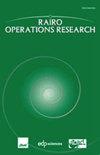概率图博弈的概率Harsanyi幂解
IF 1.8
4区 管理学
Q3 OPERATIONS RESEARCH & MANAGEMENT SCIENCE
引用次数: 0
摘要
本文分析了概率图对策(PGGs)的概率Harsanyi幂解(phps),该概率图对策的Harsanyi股利分配与概率图结构的概率幂测度确定的权重成比例。概率权力度量考虑了玩家在所有可能的确定性图中的角色,可以更有效地反映玩家的权力。给出了基于pgs和无循环概率图博弈的phps的三个公理系统,证明了phps的合理性,并分析了它们的独立性。本文章由计算机程序翻译,如有差异,请以英文原文为准。
The probabilistic Harsanyi power solutions for probabilistic graph games
This paper analyzes t he probabilistic Harsanyi power solutions (PHPSs) for probabilistic graph games (PGGs), which distribute the Harsanyi dividends proportional to weights determined by a probabilistic power measure for probabilistic graph structure. The probabilistic power measure considers the role of players in all possible deterministic graphs, which can reflect the powers of players more effectively. Three axiomatic systems of the PHPSs on PGGs and cycle-free probabilistic graph games (CFPGGs) are provided to show the rationality of the PHPSs, and their independence is analyzed.
求助全文
通过发布文献求助,成功后即可免费获取论文全文。
去求助
来源期刊

Rairo-Operations Research
管理科学-运筹学与管理科学
CiteScore
3.60
自引率
22.20%
发文量
206
审稿时长
>12 weeks
期刊介绍:
RAIRO-Operations Research is an international journal devoted to high-level pure and applied research on all aspects of operations research. All papers published in RAIRO-Operations Research are critically refereed according to international standards. Any paper will either be accepted (possibly with minor revisions) either submitted to another evaluation (after a major revision) or rejected. Every effort will be made by the Editorial Board to ensure a first answer concerning a submitted paper within three months, and a final decision in a period of time not exceeding six months.
 求助内容:
求助内容: 应助结果提醒方式:
应助结果提醒方式:


